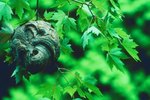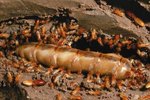
Many people fear wasps due to the insects' painful sting and potential for an allergic reaction, but wasps play a critical role in preventing insect populations from exploding. More than 30,000 species of wasps exist. Wasps are either solitary or social. Social wasps include the well-known yellow jackets and hornets. These wasps build large nest under the direction of a queen wasp. Solitary wasps account for the majority of wasp species, including mud wasps and pollen wasps.
Coloring
Yellow jackets are about a half-inch long and known for their bright yellow coloring that is striped with black. They're frequently confused with honeybees, whose coloring is more orange. In addition to the slight color difference, wasps have a pointed yellow tail and a narrow waist, further distinguishing them from rounder bees. Solitary pollen wasps also have yellow coloring, but unlike yellow jackets, they have large clubbed antennas. They are also slightly larger, measuring about three-quarters of an inch long. Hornets are social wasps, with yellow and black coloring and bodies that grow to 2 inches long. If you encounter a wasp with yellowish or brown and black stripes, you may be looking at a paper wasp, another common social wasp, which can read 1 1/2 inches long.
Body Shape
If you encounter a wasp with a slender, needle-like waist, it is probably a mud dauber or thread waist wasp. In addition, if you are having trouble distinguishing between a yellow jacket and a hornet, you will recognize the hornet by the longer and thicker body shape.
Nest Size
When you encounter a nest with multiple wasps, you are dealing with a social wasp such as yellow jackets which are frequently found in large colonies of up to 5,000 wasps in a single nest. Each nest may have between 10,000 and 15,000 cells. Hornets also build large nests of up to 700 wasps per nest. Paper wasps, another common social wasp, nest in smaller groups of five to 30.
Nest Material
Nests that sit in the open that are gray and made of paper-like material, it belongs to a paper wasp. However, if the nest is made of mud or clay, it belongs to one of the solitary mud wasp species: pollen wasp, mud daubers or potter wasps. Potter wasps are known for their small, jug-shaped nests.
References
Photo Credits
-
John Foxx/Stockbyte/Getty Images
Writer Bio
Maureen Malone started writing in 2008. She writes articles for business promotion and informational articles on various websites. Malone has a Bachelor of Science in technical management with an emphasis in biology from DeVry University.




